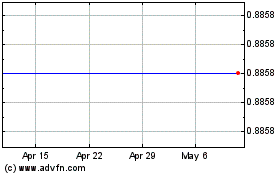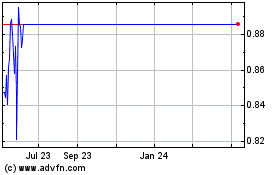U.S. retail sales rose solidly in May, the latest evidence of
accelerating growth as the Federal Reserve considers the economic
outlook amid a recent slowdown in hiring.
Led by increased spending online and at gas stations, retail
sales climbed a seasonally adjusted 0.5% in May, the Commerce
Department said Tuesday. The better-than-expected gain comes on the
heels of April's 1.3% surge, which was the strongest advance in
more than a year.
The latest data indicate consumer spending, which accounts for
two-thirds of U.S. economic output, is healthy. A separate report
from the Labor Department Tuesday showed prices for imported goods
rose by the most since 2012, an indicator that inflation could be
moving toward the Fed's 2% target.
Taken together, the latest numbers and recent soft jobs figures
present a complicated picture to Fed officials who began a two-day
policy meeting Tuesday. Stronger spending, modestly higher
inflation, a solid housing market and low layoffs shows an economy
that appears to be on decent footing. But the May jobs report
showing that hiring fell sharply had several economists moving up
their odds for a near-term recession and expecting Fed officials to
strike a cautious tone when they announce their position on the
economy and the benchmark short-term interest rate on
Wednesday.
May's job gain of just 38,000, the weakest performance since
September 2010, likely takes any rate increase off the table this
week. But if the economy is accelerating and inflation is firming,
that could give policy makers leeway to signal a rate increase
could come in July—if the hiring picture improves and a U.K. vote
over European Union membership doesn't rattle the stabilizing
global economy.
"The conundrum for the Fed is they were proven right about
weakness in the global economy and the stronger dollar—it was
largely temporary," said Jeremy Lawson, chief economist at Standard
Life Investments. "But they have to acknowledge the labor market is
softer than anticipated."
The dichotomy leaves Fed Chairwoman Janet Yellen "to walk a
tight rope" when she speaks Wednesday, he said, conveying both
confidence in the expansion's longevity but patience on when the
next rate increase could come.
The majority of economists surveyed by The Wall Street Journal
earlier this month, after the latest jobs report, predicted a July
increase in the Fed's benchmark rate. It would be the first
increase since December. But the same survey put the odds of a
recession in the next 12 months at 21%, about double what they were
a year earlier.
Broader economic growth slowed in the first quarter to a 0.8%
annualized advance. A stronger dollar hampered exports, falling oil
prices caused the energy industry to halt investment and
consumer-spending gains slowed. Each of those three factors turned
the other direction this spring, pointing to a significant
acceleration in growth.
And even the sour jobs report showed wages advanced at a
stronger pace in May, up 2.5% from a year earlier. That should give
consumers more ability to maintain strong spending.
After Tuesday's data, Credit Suisse raised its second-quarter
projection for gross domestic product to a 3% advance from 2.8%.
Macroeconomic Advisers lifted its growth projection to 2.6%. The
Federal Reserve Bank of Atlanta forecast a 2.8% gain.
The retail-sales report "provides strong support to the view
that U.S. growth is rebounding," Credit Suisse economist Jeremy
Schwartz said. "The persistence of strong consumer spending
suggests household fundamentals are not breaking down
significantly."
Stronger spending comes alongside firmer inflation readings.
Import prices rose 1.4% in April, the largest monthly gain since
March 2012. The data, however, is not seasonally adjusted and in
part reflects expected springtime increases for petroleum
products.
The Fed's preferred inflation measure, the Commerce Department's
personal consumption expenditure index, has remained below the
Fed's 2% target for four years. But the gauge, up 1.1% in April
from a year earlier, has generally trended higher for the past
year.
Tuesday's retail report showed May's gain was led by a 1.3% gain
in nonstore sales, which includes purchases on Amazon.com and its
internet rivals. That category grew 12.2% from a year earlier. By
comparison, department-store sales were down 5.8% from a year
earlier.
"We had a big uptick in April and things went very well in May,"
said Matt Verbin, chief financial officer of Chandler, Ariz.,
online discounter Tanga.com LLC. He said the gains were better than
expected given May's weak hiring.
Brick-and-mortar stores are suffering from lower mall foot
traffic and limited selection, he said. Online retailers "can be
more nimble and get the right product in front of the right
customer."
Spending at gas stations increased 2.1% last month, and
purchases of motor vehicles and parts rose 0.5%. But sales at
general merchandise stores fell 0.3%, indicating spending remains
somewhat uneven.
And previous upticks in consumer spending, including late last
year, have been quickly followed by a slowdown. That's one factor
why the seven-year-old expansion has failed to maintain a much
better than a 2% growth pace.
The "data will show fuel prices down, interest rates are low,
wages are up," Wal-Mart Stores Inc. Chief Financial Officer Brett
Biggs said recently. "All of that says consumers should be doing
fairly well, but there is still this underlying cautiousness." He
blames that wariness to the long-lingering effects of the financial
crisis.
Sarah Nassauer contributed to this article.
(END) Dow Jones Newswires
June 14, 2016 14:25 ET (18:25 GMT)
Copyright (c) 2016 Dow Jones & Company, Inc.
Credit Suisse (NYSE:CS)
Historical Stock Chart
From Mar 2024 to Apr 2024

Credit Suisse (NYSE:CS)
Historical Stock Chart
From Apr 2023 to Apr 2024
